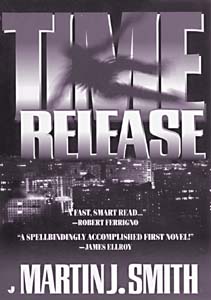![[Metroactive Books]](/books/gifs/books468.gif)
![[Metroactive Books]](/books/gifs/books468.gif)
[ Books Index | Metro | Metroactive Central | Archives ]
Tamper Tantrum
Reviewed by Christopher Weir
HELL, as a philosopher once mused, is truth seen too late. But what if that truth is imagined? Such is the question posed by Martin Smith's Time Release, a cautionary thriller that navigates the dynamic of repressed-memory syndrome.
Time Release unfolds in Pittsburgh, Pa., where an unsolved case of product-tampering murders resurfaces after a 10-year interval. Before, the vehicle of death was an over-the-counter drug called Primenyl. Now, it's everything from yogurt to shampoo, and the Pittsburgh region is coming unglued.
Dead-end detective Grady Downing thinks that the eyewitness testimony necessary to break the case is hidden under the lock of buried memory, and he needs the help of skeptical psychologist Jim Christensen, a memory expert, to find the key. Downing, it seems, botched the initial product-tampering investigation a decade earlier and is now on a mysteriously personal mission to ensnare his prime suspect: retired pharmacist Ron Corbett.
But the evidence remains thin, largely because Corbett's dysfunctional family suspiciously disintegrated shortly after the first wave of killings. Downing's only hope for an eyewitness account of Corbett's machinations resides in his younger child, Sonny, a foster-care graduate who shows signs of trauma-induced memory repression. Enter Christensen, whose professional misgivings are muted by both favors owed to Downing and by an increasingly predatory rash of poisonings.
Loaded with subliminal references to San Mateo County's Franklin murder trial--in which firefighter George Franklin's daughter, after 21 years, remembered him allegedly murdering a playmate--Time Release forges a provocative counterpoint between the prosecutorial promise of recovered memories and the desperation provoked by a cunning serial killer.
There are no easy outs in the novel's central dilemma. Should Christensen prescribe drugs to jar those memories at the risk of nudging his client into psychosis? And will those memories even be reliable or merely a mosaic of suggestion, manipulation and confusion? It's a psychological tightwire act, one that puts the screws to the ethical limits of repressed-memory therapy.
Soon, the poisonings encircle--then target--Christensen, Downing and their families, and Christensen finds himself ensnared in a dangerous game of mental roulette.
THE REAL-WORLD potential of product tampering provides a powerful subtext to the repressed-memory theme. The author's well-researched schematic yields several scenarios that are etched with disturbing plausibility. Indeed, readers may find themselves in the same predicament as Christensen when he descends into a feverish paranoia at the supermarket: "By the time he reached the end of the aisle, his eyes were those of a killer in search of opportunity."
Smith's prose reveals an increasingly rare commodity in popular fiction: finesse. The plot is intricate and exacting but never confusing. Smith conveys Christensen's integral relationship with his daughters without a trace of condescending sentimentality.
An unobtrusive yet caustic sense of humor is never too far from the narrative surface. And although the story's themes are topical, Smith resists all temptations to lecture. The result is a rapid-fire thriller that spirals to its dénouement without a snag.
Strangely, the book's few shortcomings can be traced to its page-turning appeal and almost cinematic pacing. For example, Time Release hints at a hard-boiled sensibility that doesn't have time to coalesce. Pennsylvania's industrial dystopia and the pervasive stench of murder both beg for more haunting interplay. And Christensen never fully reveals the character flaws that might galvanize a reader's sympathies.
Such are the meager quibbles with an otherwise entertaining, unsettling and compelling novel. Ultimately, you care about its characters, and with a conspiracy of turns and twists shadowing their every move, you fear for them as well. As Time Release barrels toward its conclusion, its message is clear: The world is not a safe place, and neither is the mind.
[ Metro | Metroactive Central | Archives ]
This page was designed and created by the Boulevards team.

Repressed-memory and product-tampering themes add real-world depth to new thriller
Time Release
Martin Smith
Jove Publications; 352 pages; $5.99 paper
From the February 6-12, 1997 issue of Metro